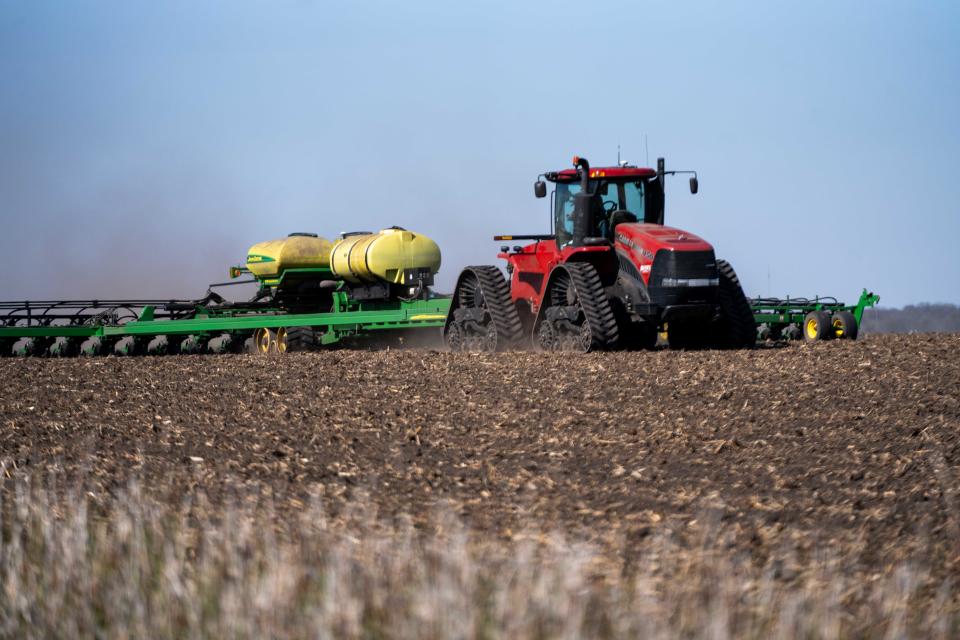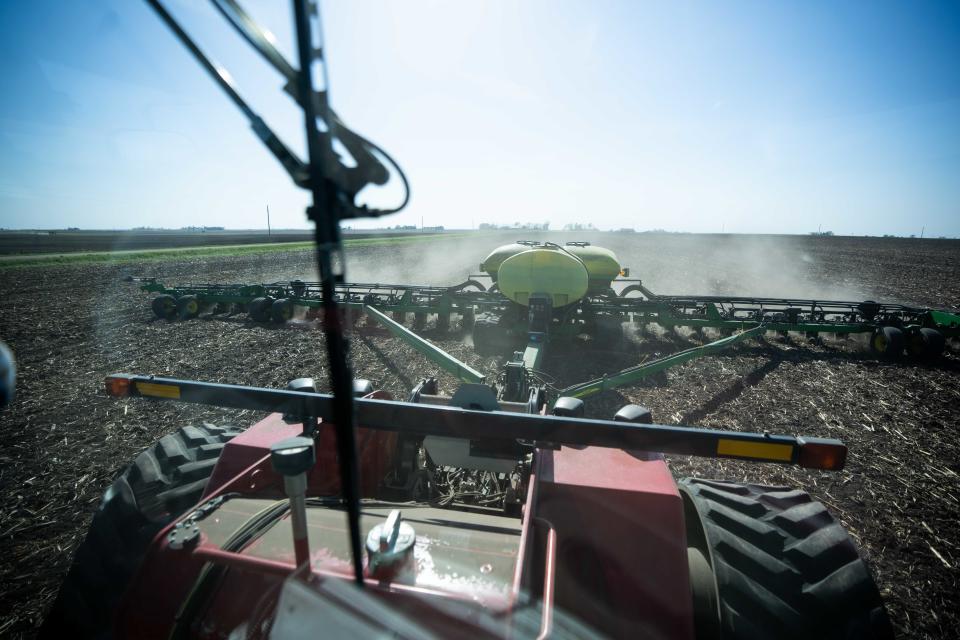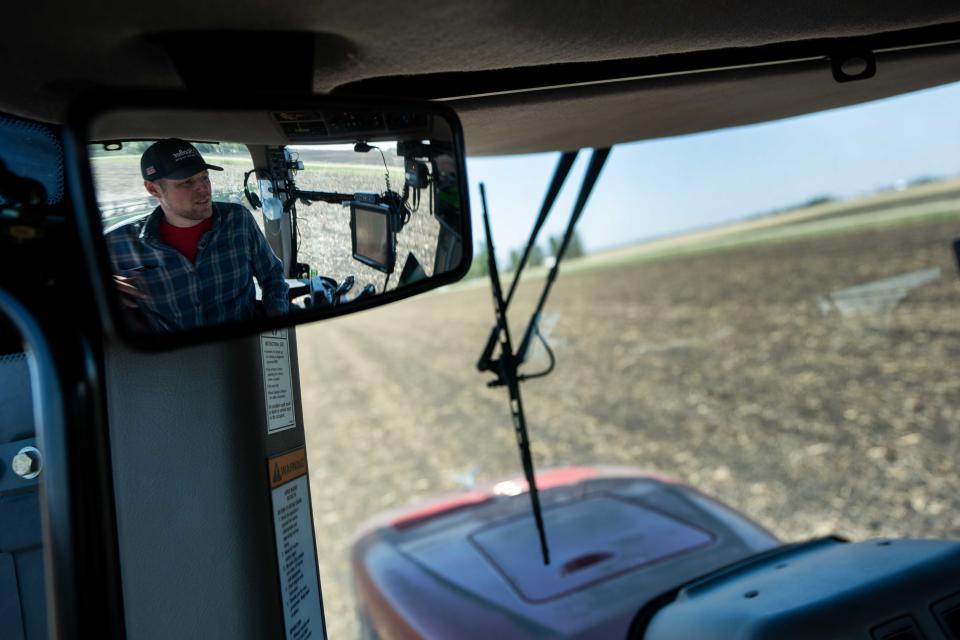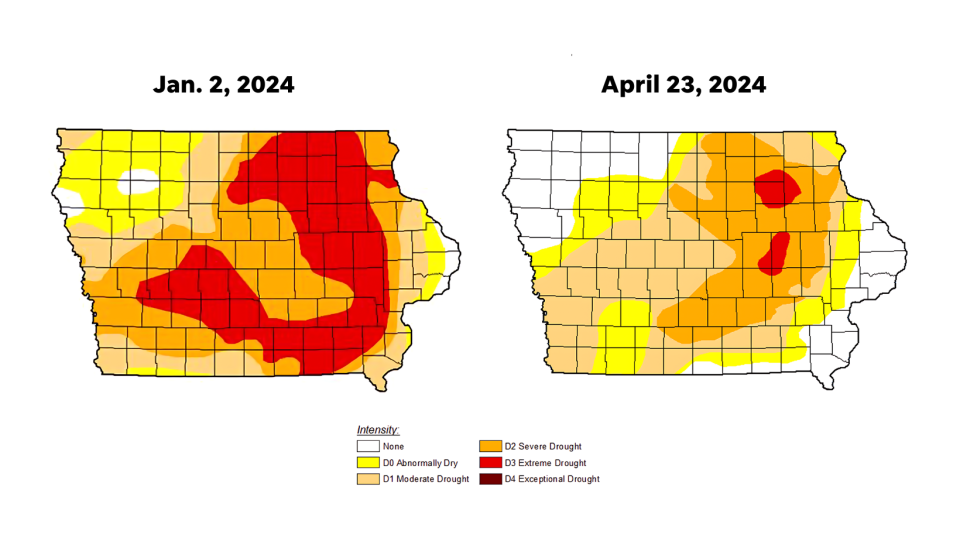Iowa farmers head into fields, hoping rains will continue, help pull state out of drought
Like other Iowa farmers, Aaron Lehman hopes that recent spring rains will help pull his north Polk County farm out of a drought that’s entering its fourth year.
“I don't think our farmers feel like they're out of the woods yet,” said Lehman, president of the Iowa Farmers Union board. “But the last few weeks have been helpful.”
So far in April, 13% of Iowa’s corn and 8% of its soybean acres already have been planted. By May 1, that number likely will push close to 50%, given some good weather, said Mark Licht, an associate Iowa State University Extension agronomy professor.

“We have really good planting conditions right now, with enough soil moisture in the top 6 inches to get good germination and emergence,” Licht said.
“That’s a bright spot,” he said, given that a month or so ago he wasn’t sure farmers had enough topsoil moisture to even get their crops started.
But while conditions have improved, Iowa has yet to escape its drought. Across the state, the drought that begin in 2021 ― the longest since a 1954 to 1959 dry spell ― has left a 20- to 30-inch moisture shortfall. Much of the precipitation hasn’t reached the parched subsoil.
It’s going to “take several months of wetter-than-normal conditions before we can declare the drought over,” said Tim Hall, the Iowa Department of Natural Resources' hydrology resources coordinator.
In addition to weather worries, farmers also face tight profit margins. Economists forecast that prices this season for corn and soybeans — Iowa’s largest crops — will be about even with costs. In Iowa, the break-even price is about $4.60 a bushel for corn and $11.25 for soybeans, said Chad Hart, an Iowa State University agricultural economist.
The USDA expects a second year of income decline for Americans farmers, with profits dropping 41% from a record high in 2022. That’s when Russia invaded Ukraine, disrupting one of the world's largest producers of sunflowers, wheat and corn and driving up demand and prices for U.S. crops.
Lehman said his members are having “really difficult and serious conversations with their farm lenders.”
“Cash flows are going to be very, very tight,” he said. “It's a stressful time.”
Drought retreats, but is it just taking a break?
Despite the economic headwinds, is there reason for optimism about growing conditions?
The severity of Iowa's drought has lessened in many areas this spring, thanks to soaking rains over large parts of the state.

Nearly 30% of Iowa remains caught in severe or extreme drought, with part of nine counties in northeast Iowa hit the hardest, the most recent edition of the U.S. Drought Monitor shows. At the start of the year, it reported about 60% of Iowa was in severe or extreme drought.
About 50% of Iowa is now in the less severe category of abnormally dry to moderate drought conditions, up from 36% in January. Nearly 25% of Iowa has no drought, nearly seven times January’s percentage.
But not everyone has benefited equally. Jake Bigelow, who farms southwest of Winterset, said he’s mostly missed the inch-plus rains nearby areas recently received. Even with forecasted showers ahead, “We might only get two-tenths again while everybody around us gets an inch and a half again," he said.
“It’s frustrating. But it’s just the way it is,” said Bigelow, who also needs more moisture for the pastures where he grazes cattle he sells to directly to customers.
The topsoil has “OK moisture. But I don't know how long it'll last without sustaining rains. That’s my concern,” he said.
Dennis Todey, U.S. Department of Agriculture Midwest Climate Hub director, said the weather pattern is shifting from El Nino to La Nina, with the new system bringing greater chances for warmer, drier conditions in the summer. While the transition's timing is unclear, it's expected to occur by summer's end.
In May, June and July, most of Iowa is forecast to have a 33%-40% chance of higher-than-normal temperatures and equal chances for above- or below-normal precipitation, according to the NOAA Climate Prediction Center.
More: Iowa tightens foreign-owned land law, but misses farmers' main concern: access to land
If Iowa crops don't get rainfall, plants will have to rely on subsoil moisture, and “you could argue we’ve probably pulled as much water as we can from the soil,” Hart said.
A few weeks of extremely hot, dry conditions could push areas into drought or deeper drought, stressing private wells and rural and municipal water supplies, said the DNR's Hall.
“We’re kind of on that knife's edge where it could go one way or the other,” he said.
Water woes extend beyond farms in some parts of Iowa
It's not just farmers who are fretting over the weather; some Iowa water supply systems are struggling. Osceola is weighing moving water from a nearby quarry or using the city’s treated wastewater to recharge West Lake, its dwindling drinking water source.
And this month, the Poweshiek Water Association ordered farmers around Tama and Amana to use water sources other than the association’s for spraying herbicides, wanting to preserve supplies for people and livestock.
Recent rains have helped replenish some ponds, creeks and pastures used to water and feed cattle and other livestock, said Denise Schwab, interim director of ISU’s Iowa Beef Center. But not all areas have been so lucky.
“It a little discouraging when you hear 2 to 3 inches of rain, and you get three-tenths,” said Schwab, whose family farms in Poweshiek County. There, farmers will need to tap either their own wells or truck water from nearby towns and cities, both for livestock and spraying.
Hauling water can be labor-intensive for producers who water cattle and other livestock daily, Schwab said.
More: Iowa board awards millions in incentives for construction of Daisy dairy plant in Boone
She tells cattle producers they may want to consider trimming their herds this summer if they’re short on forage, pasture and water. And they still can benefit from high prices.
“If we stay dry, it will help stretch their supplies,” she said.
As prices shift, so do growers' production plans

Hart, the ISU economist, says a good example of Iowa and U.S. farmer concern about profits is their shift from corn to soybeans.
The USDA reported in February that U.S. farmers would cut their corn planting by 4.6 million acres, a 5% decline from 2023. In Iowa, the nation’s largest corn grower, farmers expect to plant 12.8 million acres of corn this year, 300,000 fewer than last year. It will be the smallest corn acreage since 2006, the USDA said.
Iowa growers say they’ll plant 10.2 million soybean acres, 250,000 more than last year. Iowa is the U.S.’ second-largest soybean producer after Illinois.
“A lot of producers are trying to figure out how do I reduce expenses, save some costs?” Hart said, noting that corn carries higher seed and fertilizer costs than soybeans. “We see this shift toward soybeans when profits are tight.”
Bigelow said he’s keeping a close eye on expenses, especially with lower corn and soybean prices.
“It’s definitely a tighter market,” he said. “It's not as fun to get $4 corn as it was to get $8 corn.”
While Bigelow and other farmers see fertilizer costs declining, the most recent USDA forecast shows total production expenses will climb 3.8%.
Land, machinery, seed, chemical and other expenses aren’t retreating, said Michael Swanson, a Wells Fargo agricultural economist.
“The price run-up is not coming down during this period of softness,” Swanson said.
U.S. revenue from livestock doesn’t offer a much better outlook, with cattle, milk and egg production receipts expected to decline.
But most of Iowa's eggs, so to speak, are in a different basket. It's the nation's largest hog producer, and while last year brought record losses, this year revenue is inching slightly higher.
“Looking at pork, things have been getting better,” Hart said.
And Bigelow said lower corn prices have an upside for cattle producers like him, allowing them to lock in more profit as he feeds his herd cheaper grain.
“Having some diversity helps even out the ups and downs,” he said.
Despite drought, can Iowa harvest beat expectations again?
Despite the drought, Iowa farmers have produced large corn and soybean harvests. Last year’s soybean crop was Iowa’s third-largest on record, and corn, the state’s fifth, USDA data shows.
“It hasn’t been 2012 or 1998, when the droughts truly took a big bite out of production,” Hart said. “The drought thus far hasn’t done that.”

Paul Heineman, who farms with his brother, Craig, and their sons near Ogden, said he was among the growers surprised by the abundance of his harvest last year. Improved seed genetics help a lot, he said.
“I think we take better care of our crop than we did,” said Heineman, pointing to practices like using fungicides to protect plants from disease and splitting fertilizer applications, with part provided early in the growing season when the plants needs it most.
He hopes he and his family see another strong crop this year, despite the drought. Boone County remains in moderate drought, despite spring rains and this winter's snow soaking into the soil.
"It can't shut off now. We're going to continue to need timely rain," Heineman said.
Like the weather, smaller profit margins are on his mind.
"Farmers always sweat the weather. It's part of our DNA," he said. And markets are "the other thing we sweat."
Donnelle Eller covers agriculture, the environment and energy for the Register. Reach her at deller@registermedia.com or 515-284-8457.
This article originally appeared on Des Moines Register: Recent rainfall helps Iowa farmers, but drought remains major concern

